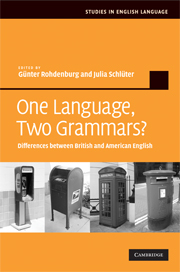Book contents
- Frontmatter
- Contents
- List of figures
- List of tables
- List of contributors
- Introduction
- 1 Colonial lag, colonial innovation or simply language change?
- 2 Compound verbs
- 3 The formation of the preterite and the past participle
- 4 Synthetic and analytic comparatives
- 5 Phonology and grammar
- 6 Prepositions and postpositions
- 7 Argument structure
- 8 Reflexive structures
- 9 Noun phrase modification
- 10 Nominal complements
- 11 Non-finite complements
- 12 The present perfect and the preterite
- 13 The revived subjunctive
- 14 The mandative subjunctive
- 15 The conditional subjunctive
- 16 Tag questions
- 17 The pragmatics of adverbs
- 18 How different are American and British English grammar? And how are they different?
- 19 New departures
- Bibliography
- Index
2 - Compound verbs
Published online by Cambridge University Press: 03 July 2009
- Frontmatter
- Contents
- List of figures
- List of tables
- List of contributors
- Introduction
- 1 Colonial lag, colonial innovation or simply language change?
- 2 Compound verbs
- 3 The formation of the preterite and the past participle
- 4 Synthetic and analytic comparatives
- 5 Phonology and grammar
- 6 Prepositions and postpositions
- 7 Argument structure
- 8 Reflexive structures
- 9 Noun phrase modification
- 10 Nominal complements
- 11 Non-finite complements
- 12 The present perfect and the preterite
- 13 The revived subjunctive
- 14 The mandative subjunctive
- 15 The conditional subjunctive
- 16 Tag questions
- 17 The pragmatics of adverbs
- 18 How different are American and British English grammar? And how are they different?
- 19 New departures
- Bibliography
- Index
Summary
Introduction
Among the differences that exist between American and British English some concern the use of compound verbs such as to baby-sit, to daydream, to highlight, to mastermind, to pinpoint, to short-change, to troubleshoot, to wiretap. These differences are rarely mentioned in the literature and have played no prominent role in the textbooks comparing the two varieties (Bauer 2002, Gramley and Pätzold 2003, Tottie 2002a, Trudgill and Hannah 2002). In studies of English word formation, on the other hand, these compounds have been dealt with from both a synchronic and a diachronic point of view (Adams 2001, Plag 2003). There has been a lively debate about the word-formational status of these verbal units dating back at least to Marchand (1969). While compound nouns, adjectives and adverbs are generally considered to be genuine compounds, which combine two or more free forms with one another, e.g. opinion poll (the latest opinion poll), oilrich (oilrich countries), stock-still (The deer stood stock-still for a moment), Marchand took these verbs to be not genuine compounds, but secondary combinations which are derived from non-verbal compounds. He distinguished between compound and pseudo-compound verbs. In accordance with the definition of endocentric compounds, Marchand accepted only verbs preceded by a particle such as to overrate and to underrate as genuine compound verbs. They are compound verbs because the two free morphemes follow the determinant–determinatum pattern, with a verb for their determinatum, and a particle for their determinant (Marchand 1969: 96).
- Type
- Chapter
- Information
- One Language, Two Grammars?Differences between British and American English, pp. 38 - 59Publisher: Cambridge University PressPrint publication year: 2009
- 4
- Cited by

